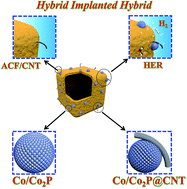Hybrid implanted hybrid hollow nanocube electrocatalyst facilitates efficient hydrogen evolution activity†
Abstract
The rational design of metal–organic framework (MOF)-derived electrocatalysts with homogeneous compositions and nonspherical hollow nanostructure for the hydrogen evolution reaction (HER) remains a major challenge. In this work, we report “hybrid implanted hybrid” electrocatalysts that consist of composition controllable Co and Co2P hybrids confined in a defect-rich carbon nanotube (CNT) and N-doped amorphous carbon (ACF) hollow nanocube hybrid (Co/Co2P@ACF/CNT HNCs) derived from ZIF67 nanocubes for efficient hydrogen evolution reaction (HER). This electrocatalyst was achieved by the simple etching-pyrolysis-phosphidation of Co-centered ZIF67 nanocubes (NCs). When used as an electrocatalyst for the HER, Co/Co2P@ACF/CNT HNCs annealed at 900 °C required a minimum overpotential of 78 mV to reach a current density of 10 mA cm−2 and remained highly stable in KOH electrolyte for up to 48 h of electrolysis. Theoretical evaluations confirm that there exist electronic interactions and multiple synergistic effects between the Co/Co2P hybrid and ACF/CNT hybrid, which are responsible for simultaneously modulating the water dissociation, increasing the number of active sites, increasing the electronic states of Co d-bands and optimizing the hydrogen adsorption energy towards achieving high HER catalytic performance. This present work supplied a facile route toward the design of highly active, durable and inexpensive HER electrocatalysts.



 Please wait while we load your content...
Please wait while we load your content...